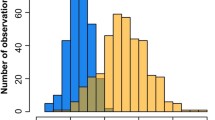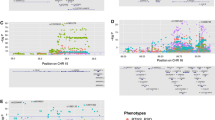Abstract
Skin color, a predictor of social interactions and risk factor for several types of cancer, is due to two contrasting forms of melanin, the darker eumelanin and lighter phaeomelanin. The lighter pigment phaeomelanin is the product of the antagonistic function of the agouti signaling protein (ASIP) on the α-melanocyte stimulating hormone receptor (MC1R). Studies have shown that a single-nucleotide polymorphism (SNP) in the 3′UTR of the ASIP gene is associated with dark hair and eyes; however, little is known about its role in inter-individual variation in skin color. Here we examine the relationship between the ASIP g.8818A>G SNP and skin color (M index) as assessed by reflectometry in 234 African Americans. Analyses of variance (ANOVA) were performed to evaluate the effects of ASIP genotypes, age, individual ancestry, and sex on skin color variation. Significant effects on M index variation were observed for ASIP genotypes (F(2,236)=4.37, P=0.01), ancestry (F(1,243)=37.2, P<0.001), and sex (F(1,244)=4.08, P=0.05). Subsequent analyses revealed a strong effect on M index from ASIP genotypes in African American females (P<0.001). Our study suggests that the ASIP G>A polymorphism exhibits a dominant effect leading to lighter skin color and that variation in the ASIP gene may have been one of several factors contributing to reductions in pigmentation in some populations. Further study is needed to reveal how interactions between ASIP and several other genes, such as MC1R and P, predict human pigmentation.

Similar content being viewed by others
References
Alaluf S, Atkins D, Barrett K, Blount M, Carter N, Heath A (2002) Ethnic variation in melanin content and composition in photoexposed and photoprotected human skin. Pigment Cell Res 15:112–118
Bonilla C (2003) Admixture in three Hispanic populations: ancestry proportions, population structure, and gene mapping. PhD dissertation, The Pennsylvania State University, Pennsylvania
Bonilla C, Shriver M, Parra E, Jones A, Fernandez J (2004) Ancestral proportions and their association with skin pigmentation and bone mineral density in Puerto Rican women from New York city. Hum Genet 115:57–68
Halder I, Shriver M (2003) Measuring and using admixture to study the genetics of complex diseases. Hum Genomics 1:52–62
Hanis C, Chakraborty R, Ferrell R, Schull W (1986) Individual admixture estimates: disease associations and individual risk of diabetes and gallbladder disease among Mexican-Americans in Starr County, Texas. Am J Phys Anthropol 70:433–441
Hoggart C, Parra E, Shriver M, Bonilla C, Kittles R, Clayton D, McKeigue P (2003) Control of confounding of genetic associations in stratified populations. Am J Hum Genet 72:1492–1504
Hunt G, Donatien P, Lunec J, Todd C, Kyne S, Thody A (1994) Cultured human melanocytes respond to MSH peptides and ACTH. Pigment Cell Res 7:217–221
Kanetsky P, Swoyer J, Panossian S, Holmes R, Guerry D, Rebbeck T (2002) A polymorphism in the agouti signaling protein gene is associated with human pigmentation. Am J Hum Genet 70:770–775
Kittles R, Chen W, Panguluri R, Ahaghotu C, Jackson A, Ademabowo C, Griffin R, Williams T, Ukoli F, Adams-Campbell L, Kwagyan J, Isaacs W, Freeman V, Dunston G (2002) CYP3A4-V and prostate cancer in African Americans: causal or confounding association because of population stratification? Hum Genet 110:553–560
Lu D, Willard D, Patel I, Kadwell S, Overton L, Kost T, Luther M, Chen W, Woychik R, Wilkinson W, Cone R (1994) Agouti protein is an antagonist of the melanocyte-stimulating-hormone receptor. Nature 371:799–802
Parra E, Hoggart C, Bonilla C, Dios S, Norris J, Marshall J, Hamman R, Ferrell R, McKeigue P, Shriver M (2004) Relation of type 2 diabetes to individual admixture and candidate gene polymorphisms in the Hispanic American population of San Luis Valley, Colorado. J Med Genet 41:e116
Rees J (2003) Genetics of hair and skin color. Annu Rev Genet 37:67–90
Robins A (1991) Biological perspectives on human pigmentation. Cambridge University Press, Cambridge
Shriver M, Kittles R (2004) Opinion: genetic ancestry and the search for personalized genetic histories. Nat Rev Genet 5:611–618
Shriver MD, Parra EJ (2000) Comparison of narrow-band reflectance spectroscopy and tristimulus colorimetry for measurements of skin and hair color in persons of different biological ancestry. Am J Phys Anthropol 112:17-27
Shriver M, Parra E, Dios S, Bonilla C, Norton H, Jovel C, Pfaff C, Jones C, Massac A, Cameron N, Baron A, Jackson T, Argyropoulos G, Jin L, Hoggart C, McKeigue P, Kittles R (2003) Skin pigmentation, biogeographical ancestry and admixture mapping. Hum Genet 112:387–399
Suzuki I, Tada A, Ollmann M, Barsh G, Im S, Lamoreux M, Hearing V, Nordlund J, Abdel-Malek Z (1997) Agouti signaling protein inhibits melanogenesis and the response of human melanocytes to alpha-melanotropin. J Invest Dermatol 108:838–842
Voisey J, Van Daal A (2002) Agouti: from mouse to man, from skin to fat. Pigment Cell Res 15:10–18
Voisey J, Imbeault P, Hutley L, Prins J, Van Daal A (2002) Body mass index-related human adipocyte agouti expression is sex-specific but not depot-specific. Obes Res 10:447–452
Voisey J, Kelly G, Van Daal A (2003) Agouti signal protein regulation in human melanoma cells. Pigment Cell Res 16:65–71
Wilson B, Ollmann M, Kang L, Stoffel M, Bell G, Barsh G (1995) Structure and function of ASP, the human homolog of the mouse agouti gene. Hum Mol Genet 4:223–230
Zeigler-Johnson C, Panossian S, Gueye S, Jalloh M, Ofori-Adjei D, Kanetsky P (2004) Population differences in the frequency of the agouti signaling protein g.8188A>G polymorphism. Pigment Cell Res 17:185–187
Acknowledgements
We are grateful to all individuals who participated in this study. We also thank Dale Young, Aisha Massac, and Cecily Jones for assistance in recruitment and data processing. Support for this work was provided by a Howard University, New Faculty Award (to R.A.K.) and the National Institutes of Health Office of Research on Minority Health (ORMH), the National Center for Research Resources (NCRR) and the National Human Genome Research Institute (NHGRI) (Grant ##GO2154 to M.D.S.).
Author information
Authors and Affiliations
Corresponding author
Rights and permissions
About this article
Cite this article
Bonilla, C., Boxill, LA., Donald, S.A.M. et al. The 8818G allele of the agouti signaling protein (ASIP) gene is ancestral and is associated with darker skin color in African Americans. Hum Genet 116, 402–406 (2005). https://doi.org/10.1007/s00439-004-1251-2
Received:
Accepted:
Published:
Issue Date:
DOI: https://doi.org/10.1007/s00439-004-1251-2




